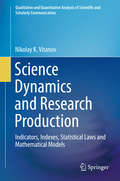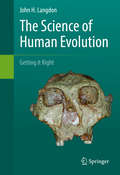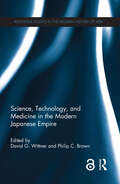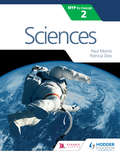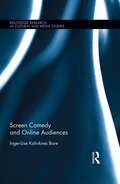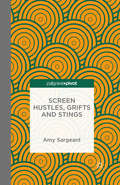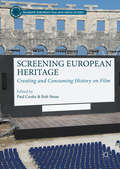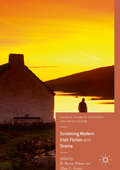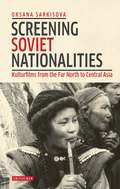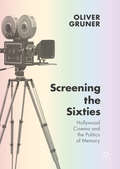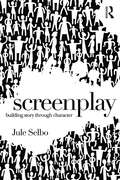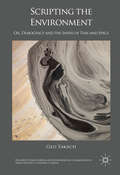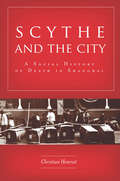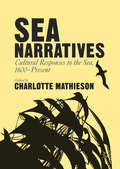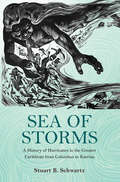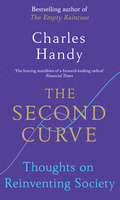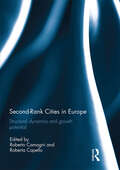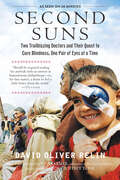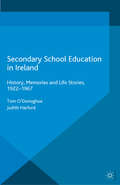- Table View
- List View
Science Dynamics and Research Production: Indicators, Indexes, Statistical Laws and Mathematical Models (Qualitative and Quantitative Analysis of Scientific and Scholarly Communication)
by Nikolay K. VitanovThis book deals with methods to evaluate scientific productivity. In the book statistical methods, deterministic and stochastic models and numerous indexes are discussed that will help the reader to understand the nonlinear science dynamics and to be able to develop or construct systems for appropriate evaluation of research productivity and management of research groups and organizations. The dynamics of science structures and systems is complex, and the evaluation of research productivity requires a combination of qualitative and quantitative methods and measures. The book has three parts. The first part is devoted to mathematical models describing the importance of science for economic growth and systems for the evaluation of research organizations of different size. The second part contains descriptions and discussions of numerous indexes for the evaluation of the productivity of researchers and groups of researchers of different size (up to the comparison of research productivities of research communities of nations). Part three contains discussions of non-Gaussian laws connected to scientific productivity and presents various deterministic and stochastic models of science dynamics and research productivity. The book shows that many famous fat tail distributions as well as many deterministic and stochastic models and processes, which are well known from physics, theory of extreme events or population dynamics, occur also in the description of dynamics of scientific systems and in the description of the characteristics of research productivity. This is not a surprise as scientific systems are nonlinear, open and dissipative.
Science Education, Career Aspirations and Minority Ethnic Students
by Billy WongIs science typically for White men? Is science for 'people like us'? What are the barriers and opportunities? This book explores the science career aspirations of minority ethnic students. It investigates the views, experiences and identities of British Black Caribbean, Bangladeshi, Chinese, Indian and Pakistani youths in relation to science.
Science, Entertainment and Television Documentary
by Vincent CampbellThe shift from traditional documentary to “factual entertainment” television has been the subject of much debate and criticism, particularly with regard to the representation of science. New types of factual programming that combine documentary techniques with those of entertainment formats (such as drama, game-shows and reality TV) have come in for strident criticism. Often featuring spectacular visual effects produced by Computer Generated Imagery these programmes blur the boundaries between mainstream science and popular beliefs. Through close analysis of programmes across a range of sciences, this book explores these issues to see if criticisms of such hybrid programmes as representing the “rotting carcass of science TV” really are valid. Campbell considers if in fact; when considered in relation to the principles, practices and communication strategies of different sciences; these shows can be seen to offer more complex and rich representations that construct sciences as objects of wonder, awe and the sublime.
The Science of Human Evolution: Getting it Right
by John H. LangdonThis textbook provides a collection of case studies in paleoanthropology demonstrating the method and limitations of science. These cases introduce the reader to various problems and illustrate how they have been addressed historically. The various topics selected represent important corrections in the field, some critical breakthroughs, models of good reasoning and experimental design, and important ideas emerging from normal science.
Science, Technology, and Medicine in the Modern Japanese Empire (Routledge Studies in the Modern History of Asia)
by David G. Wittner Philip C. BrownScience, technology, and medicine all contributed to the emerging modern Japanese empire and conditioned key elements of post-war development. As the only emerging non-Western country that was a colonial power in its own right, Japan utilized these fields not only to define itself as racially different from other Asian countries and thus justify its imperialist activities, but also to position itself within the civilized and enlightened world with the advantages of modern science, technologies, and medicine. This book explores the ways in which scientists, engineers and physicians worked directly and indirectly to support the creation of a new Japanese empire, focussing on the eve of World War I and linking their efforts to later post-war developments. By claiming status as a modern, internationally-engaged country, the Japanese government was faced with having to control pathogens that might otherwise not have threatened the nation. Through the use of traditional and innovative techniques, this volume shows how the government was able to fulfil the state’s responsibility to protect society to varying degrees. Chapter 14 of this book is freely available as a downloadable Open Access PDF under a Creative Commons Attribution-Non Commercial-No Derivatives 3.0 license. https://s3-us-west-2.amazonaws.com/tandfbis/rt-files/docs/Open+Access+Chapters/9781138905337_oachapter14.pdf
Science, Technology, and Medicine in the Modern Japanese Empire (Routledge Studies in the Modern History of Asia)
by David G. Wittner Philip C. BrownScience, technology, and medicine all contributed to the emerging modern Japanese empire and conditioned key elements of post-war development. As the only emerging non-Western country that was a colonial power in its own right, Japan utilized these fields not only to define itself as racially different from other Asian countries and thus justify its imperialist activities, but also to position itself within the civilized and enlightened world with the advantages of modern science, technologies, and medicine. This book explores the ways in which scientists, engineers and physicians worked directly and indirectly to support the creation of a new Japanese empire, focussing on the eve of World War I and linking their efforts to later post-war developments. By claiming status as a modern, internationally-engaged country, the Japanese government was faced with having to control pathogens that might otherwise not have threatened the nation. Through the use of traditional and innovative techniques, this volume shows how the government was able to fulfil the state’s responsibility to protect society to varying degrees. Chapter 14 of this book is freely available as a downloadable Open Access PDF under a Creative Commons Attribution-Non Commercial-No Derivatives 3.0 license. https://s3-us-west-2.amazonaws.com/tandfbis/rt-files/docs/Open+Access+Chapters/9781138905337_oachapter14.pdf
Sciences for the IB MYP 2 (PDF)
by Paul Morris Patricia DeoA concept-driven and assessment-focused approach to Sciences teaching and learning.- Approaches each chapter with statements of inquiry framed by key and related concepts, set in a global context- Supports every aspect of assessment using tasks designed by an experienced MYP educator- Differentiates and extends learning with research projects and interdisciplinary opportunities- Applies global contexts in meaningful ways to offer an MYP Sciences programme with an internationally-minded perspectiveContents list1 Where are we now and where are we going? 2 How do we map matter?3 Who are we? 4 How can we find out? 5 How does our planet work?6 How do we respond to our world?
Screen Comedy and Online Audiences (Routledge Research in Cultural and Media Studies)
by Inger-Lise Kalviknes BoreThe question of why we laugh (or don't laugh) has intrigued scholars since antiquity. This book contributes to that debate by exploring how we evaluate screen comedy. What kinds of criteria do we use to judge films and TV shows that are meant to be funny? And what might that have to do with our social and cultural backgrounds, or with wider cultural ideas about film, TV, comedy, quality and entertainment? The book examines these questions through a study of audience responses posted to online facilities such as Twitter, Facebook, review sites, blogs and message boards. Bore’s analysis of these responses considers a broad range of issues, including how audiences perceive the idea of "national" comedy; what they think of female comedians; how they evaluate romcoms, sitcoms and web comedy; what they think is acceptable to joke about; what comedy fans get excited about; how fans interact with star comedians; and what comedy viewers really despise. The book demonstrates some of the ways in which we can adapt theories of humour and comedy to examine the practices of contemporary screen audiences, while offering new insights into how they negotiate the opportunities and constrictions of different online facilities to share their views and experiences.
Screen Comedy and Online Audiences (Routledge Research in Cultural and Media Studies)
by Inger-Lise Kalviknes BoreThe question of why we laugh (or don't laugh) has intrigued scholars since antiquity. This book contributes to that debate by exploring how we evaluate screen comedy. What kinds of criteria do we use to judge films and TV shows that are meant to be funny? And what might that have to do with our social and cultural backgrounds, or with wider cultural ideas about film, TV, comedy, quality and entertainment? The book examines these questions through a study of audience responses posted to online facilities such as Twitter, Facebook, review sites, blogs and message boards. Bore’s analysis of these responses considers a broad range of issues, including how audiences perceive the idea of "national" comedy; what they think of female comedians; how they evaluate romcoms, sitcoms and web comedy; what they think is acceptable to joke about; what comedy fans get excited about; how fans interact with star comedians; and what comedy viewers really despise. The book demonstrates some of the ways in which we can adapt theories of humour and comedy to examine the practices of contemporary screen audiences, while offering new insights into how they negotiate the opportunities and constrictions of different online facilities to share their views and experiences.
Screen Hustles, Grifts and Stings: Stings, Grifts, Hustles and the Long Con
by A. SargeantScreen Hustles, Grifts and Stings identifies recurrent themes and techniques of the con film, suggests precedents in literature and discusses the perennial appeal of the con man for readers and viewers alike. Core studies span from film (Catch Me If You Can, Paper Moon, House of Games) to television (Hustle), from Noir (The Grifters) to Romantic Comedy (Gambit). Frequently, the execution of the con is only finely distinguishable from the conduct of a legitimate profession and, challengingly, a mark is often shown to be culpable in his or her undoing. The best con films, it is suggested, invite re-watching and reward the viewer accordingly: who is complicit and when? How and where is the con achieved? When is the viewer party to the con? And what, if any, moral is to be drawn?
Screening European Heritage: Creating and Consuming History on Film (Palgrave European Film and Media Studies)
by Rob Stone Paul CookeThis book provides a unique examination of the way Europe’s past is represented on contemporary screens and what this says about contemporary cultural attitudes to history. How do historical dramas come to TV and cinema screens across Europe? How is this shaped by the policies and practices of cultural institutions, from media funding boards to tourist agencies and heritage sites? Who watches these productions and how are they consumed in cinemas, on TV and online?, are just some of the questions this volume seeks to answer. From The Lives of Others to Game of Thrones, historical dramas are a particularly visible part of mainstream European film production, often generating major national debates on the role of the past in contemporary national identity construction.
Screening Modern Irish Fiction and Drama (Palgrave Studies in Adaptation and Visual Culture)
by R. Barton Palmer Marc C. ConnerThis book offers the first comprehensive discussion of the relationship between Modern Irish Literature and the Irish cinema, with twelve chapters written by experts in the field that deal with principal films, authors, and directors. This survey outlines the influence of screen adaptation of important texts from the national literature on the construction of an Irish cinema, many of whose films because of cultural constraints were produced and exhibited outside the country until very recently. Authors discussed include George Bernard Shaw, Oscar Wilde, Liam O’Flaherty, Christy Brown, Edna O’Brien, James Joyce, and Brian Friel. The films analysed in this volume include THE QUIET MAN, THE INFORMER, MAJOR BARBARA, THE GIRL WITH GREEN EYES, MY LEFT FOOT, THE PICTURE OF DORIAN GRAY, THE SNAPPER, and DANCING AT LUGHNASA. The introduction features a detailed discussion of the cultural and political questions raised by the promotion of forms of national identity by Ireland’s literary and cinematic establishments.
Screening Soviet Nationalities: Kulturfilms from the Far North to Central Asia (KINO - The Russian and Soviet Cinema)
by Oksana SarkisovaFilmmakers in the early decades of the Soviet Union sought to create a cinematic map of the new state by portraying its land and peoples on screen. Such films created blueprints of the Soviet domain's scenic, cultural and ethnographic perimeters and brought together – in many ways disparate – nations under one umbrella. Categorised as kulturfilms, they served as experimental grounds for developing the cinematic formulae of a multiethnic, multinational Soviet identity.
Screening the Sixties: Hollywood Cinema and the Politics of Memory
by Oliver GrunerThis book provides a detailed and engaging account of how Hollywood cinema has represented and ‘remembered’ the Sixties. From late 1970s hippie musicals such as Hair and The Rose through to recent civil rights portrayals The Help and Lee Daniels’ The Butler, Oliver Gruner explores the ways in which films have engaged with broad debates on America’s recent past. Drawing on extensive archival research, he traces production history and script development, showing how a group of politically engaged filmmakers sought to offer resonant contributions to public memory. Situating Hollywood within a wider series of debates taking place in the US public sphere, Screening the Sixties offers a rigorous and innovative study of cinema’s engagement with this most contested of epochs.
Screenplay: Building Story Through Character
by Jule SelboScreenplay: Building Story Through Character is designed to help screenwriters turn simple or intricate ideas into exciting, multidimensional film narratives with fully-realized characters. Based on Jule Selbo’s unique 11-step structure for building story through characters, the book teaches budding screenwriters the skills to focus and shape their ideas, turning them into stories filled with character development, strong plot elements based on obstacles and conflicts, and multifaceted emotional arcs. Using examples and analysis from classic and contemporary films across a range of genres, from The Godfather to Guardians of the Galaxy, Selbo’s Screenplay takes students inside the scriptwriting process, providing a broad overview for both beginners and seasoned writers alike. The book is rounded out with discussion questions, writing exercises, a guide to the business of screenwriting, in-depth film breakdowns, and a glossary of screenwriting terms.
Screenplay: Building Story Through Character
by Jule SelboScreenplay: Building Story Through Character is designed to help screenwriters turn simple or intricate ideas into exciting, multidimensional film narratives with fully-realized characters. Based on Jule Selbo’s unique 11-step structure for building story through characters, the book teaches budding screenwriters the skills to focus and shape their ideas, turning them into stories filled with character development, strong plot elements based on obstacles and conflicts, and multifaceted emotional arcs. Using examples and analysis from classic and contemporary films across a range of genres, from The Godfather to Guardians of the Galaxy, Selbo’s Screenplay takes students inside the scriptwriting process, providing a broad overview for both beginners and seasoned writers alike. The book is rounded out with discussion questions, writing exercises, a guide to the business of screenwriting, in-depth film breakdowns, and a glossary of screenwriting terms.
Scripting the Environment: Oil, Democracy and the Sands of Time and Space (Palgrave Studies in Media and Environmental Communication)
by Geo TakachThis volume explores how to engage audiences both beyond and within the academy more deeply in environmental research through arts-based forms. It builds on a multi-pronged case study of scripts for documentary film, audio-visual and stage formats, focusing on how the identity of a place is constructed and contested in the face of environmental concerns around fossil-fuel extraction in a globalized, visual society--and specifically on the rising, international public-relations war over Alberta’s stewardship of the tar sands. Each script is followed by discussion of the author’s choices of initiating idea, research sources, format, voices, world of the story, structure and visual style, and other notes on the convergence of synthesis, analysis and (re)presentation in the script. Included are lively analysis and commentary on screenwriting and playwriting theory, the creation and dissemination of the scripts, and reflections to ground a proposed framework for writing eco-themed scripts for screen, audio-visual and stage formats.
Scythe and the City: A Social History of Death in Shanghai
by Christian HenriotThe issue of death has loomed large in Chinese cities in the modern era. Throughout the Republican period, Shanghai swallowed up lives by the thousands. Exposed bodies strewn around in public spaces were a threat to social order as well as to public health. In a place where every group had its own beliefs and set of death and funeral practices, how did they adapt to a modern, urbanized environment? How did the interactions of social organizations and state authorities manage these new ways of thinking and acting? Recent historiography has almost completely ignored the ways in which death created such immense social change in China. Now, Scythe and the City corrects this problem. Christian Henriot's pioneering and original study of Shanghai between 1865 and 1965 offers new insights into this crucial aspect of modern society in a global commercial hub and guides readers through this tumultuous era that radically redefined the Chinese relationship with death.
Sea Narratives: Cultural Responses To The Sea, 1600 Present
by Charlotte MathiesonSea Narratives: Cultural Responses to the Sea, 1600-Present explores the relationship between the sea and culture from the early modern period to the present. The collection uses the concept of the ‘sea narrative’ as a lens through which to consider the multiple ways in which the sea has shaped, challenged, and expanded modes of cultural representation to produce varied, contested and provocative chronicles of the sea across a variety of cultural forms within diverse socio-cultural moments. Sea Narratives provides a unique perspective on the relationship between the sea and cultural production: it reveals the sea to be more than simply a source of creative inspiration, instead showing how the sea has had a demonstrable effect on new modes and forms of narration across the cultural sphere, and in turn, how these forms have been essential in shaping socio-cultural understandings of the sea. The result is an incisive exploration of the sea’s force as a cultural presence.
Sea of Storms: A History of Hurricanes in the Greater Caribbean from Columbus to Katrina
by Stuart B. SchwartzThe diverse cultures of the Caribbean have been shaped as much by hurricanes as they have by diplomacy, commerce, or the legacy of colonial rule. In this panoramic work of social history, Stuart Schwartz examines how Caribbean societies have responded to the dangers of hurricanes, and how these destructive storms have influenced the region's history, from the rise of plantations, to slavery and its abolition, to migrations, racial conflict, and war.Taking readers from the voyages of Columbus to the devastation of Hurricane Katrina, Schwartz looks at the ethical, political, and economic challenges that hurricanes posed to the Caribbean’s indigenous populations and the different European peoples who ventured to the New World to exploit its riches. He describes how the United States provided the model for responding to environmental threats when it emerged as a major power and began to exert its influence over the Caribbean in the nineteenth century, and how the region’s governments came to assume greater responsibilities for prevention and relief, efforts that by the end of the twentieth century were being questioned by free-market neoliberals. Schwartz sheds light on catastrophes like Katrina by framing them within a long and contentious history of human interaction with the natural world.Spanning more than five centuries and drawing on extensive archival research in Europe and the Americas, Sea of Storms emphasizes the continuing role of race, social inequality, and economic ideology in the shaping of our responses to natural disaster.
The Second Curve: Thoughts on Reinventing Society
by Charles HandyBritain's leading guru looks to the future.Charles Handy is one of the giants of contemporary thought. His books on management – including Understanding Organizations and Gods of Management – have changed the way we view business. His work on broader issues and trends – such as Beyond Certainty – has changed the way we view society. In The Second Curve, Handy builds on a life's work to glimpse into the future and see what challenges and opportunities lie ahead. He looks at current trends in capitalism and asks whether it is a sustainable system. He explores the dangers of a society built on credit. He challenges the myth that remorseless growth is essential. He even asks whether we should rethink our roles in life – as students, parents, workers and voters – and what the aims of an ideal society of the future should be. Provocative and thoughtful as ever, he sets out the questions we all need to ask ourselves – and points us in the direction of some of the answers.
Second Rank Cities in Europe: Structural Dynamics and Growth Potential
by Roberto Camagni Roberta CapelloSecond-rank cities are back on the academic scene, capturing the interest of scholars with their unexpected recent performance with respect to first-rank cities. Looking at the data on average urban GDP growth in 139 European cities since 1996, the relatively strong position of large cities (over 1.5 million inhabitants) on national growth coincides with the periods of fastest expansion, while at times of slowdown second-rank cities prevail. Especially in the recent period of economic downturn, second-rank cities have recorded annual GDP growth rates much less negative than those of capital cities; and in some European countries, like Austria and Germany, all cities have outperformed their capitals. In explaining this phenomenon, linking urban dynamics to agglomeration theories seems the most interesting approach. However, merely to link agglomeration economies to urban size in order to interpret urban performance is neither convincing nor sufficient, and it calls for additional investigation into how agglomeration economies work. This volume claims that interpretation of the current dynamics in European urban systems – especially in the western part of Europe – would benefit from exploitation of the traditional concept of agglomeration economies. However, necessary for this purpose are more in-depth considerations on the nature, scope, intensity, and causes of agglomeration economies which do not relate their existence solely to urban size. And this is where the main challenge for scholars lies, in the interpretation of the missing link between agglomeration economies and urban dynamics. This book was originally published as a special issue of European Planning Studies.
Second Rank Cities in Europe: Structural Dynamics and Growth Potential
by Roberto Camagni Roberta CapelloSecond-rank cities are back on the academic scene, capturing the interest of scholars with their unexpected recent performance with respect to first-rank cities. Looking at the data on average urban GDP growth in 139 European cities since 1996, the relatively strong position of large cities (over 1.5 million inhabitants) on national growth coincides with the periods of fastest expansion, while at times of slowdown second-rank cities prevail. Especially in the recent period of economic downturn, second-rank cities have recorded annual GDP growth rates much less negative than those of capital cities; and in some European countries, like Austria and Germany, all cities have outperformed their capitals. In explaining this phenomenon, linking urban dynamics to agglomeration theories seems the most interesting approach. However, merely to link agglomeration economies to urban size in order to interpret urban performance is neither convincing nor sufficient, and it calls for additional investigation into how agglomeration economies work. This volume claims that interpretation of the current dynamics in European urban systems – especially in the western part of Europe – would benefit from exploitation of the traditional concept of agglomeration economies. However, necessary for this purpose are more in-depth considerations on the nature, scope, intensity, and causes of agglomeration economies which do not relate their existence solely to urban size. And this is where the main challenge for scholars lies, in the interpretation of the missing link between agglomeration economies and urban dynamics. This book was originally published as a special issue of European Planning Studies.
Second Suns: Two Trailblazing Doctors and Their Quest to Cure Blindness, One Pair of Eyes at a Time
by David Oliver RelinNow in paperback: a #1 New York Times–bestselling author&’s gripping chronicle of &“two doctors . . . bringing light to those in darkness&” (Time) Second Suns is the unforgettable true story of two very different doctors with a common mission: to rid the world of preventable blindness. Dr. Geoffrey Tabin was the high-achieving &“bad boy&” of his class at Harvard Medical School. Dr. Sanduk Ruit grew up in a remote village in the Himalayas, where cataract blindness—easily curable in modern hospitals—amounts to an epidemic. Together, they pioneered a new surgical method, by which they have restored sight to over 100,000 people—all for about $20 per operation. Master storyteller David Oliver Relin brings the doctors&’ work to vivid life through poignant portraits of their patients, from old men who can once again walk treacherous mountain trails, to children who can finally see their mothers&’ faces. The Himalayan Cataract Project is changing the world—one pair of eyes at a time.
Secondary School Education in Ireland: History, Memories and Life Stories, 1922 - 1967 (Historical Studies in Education)
by Tom O'Donoghue Judith HarfordAdopting a life story approach, this book explores the memories of those who attended Irish secondary schools prior to 1967. It serves to initiate and enhance the practice of remembering secondary school education amongst those who attended secondary schools not just in Ireland, but around the world.
